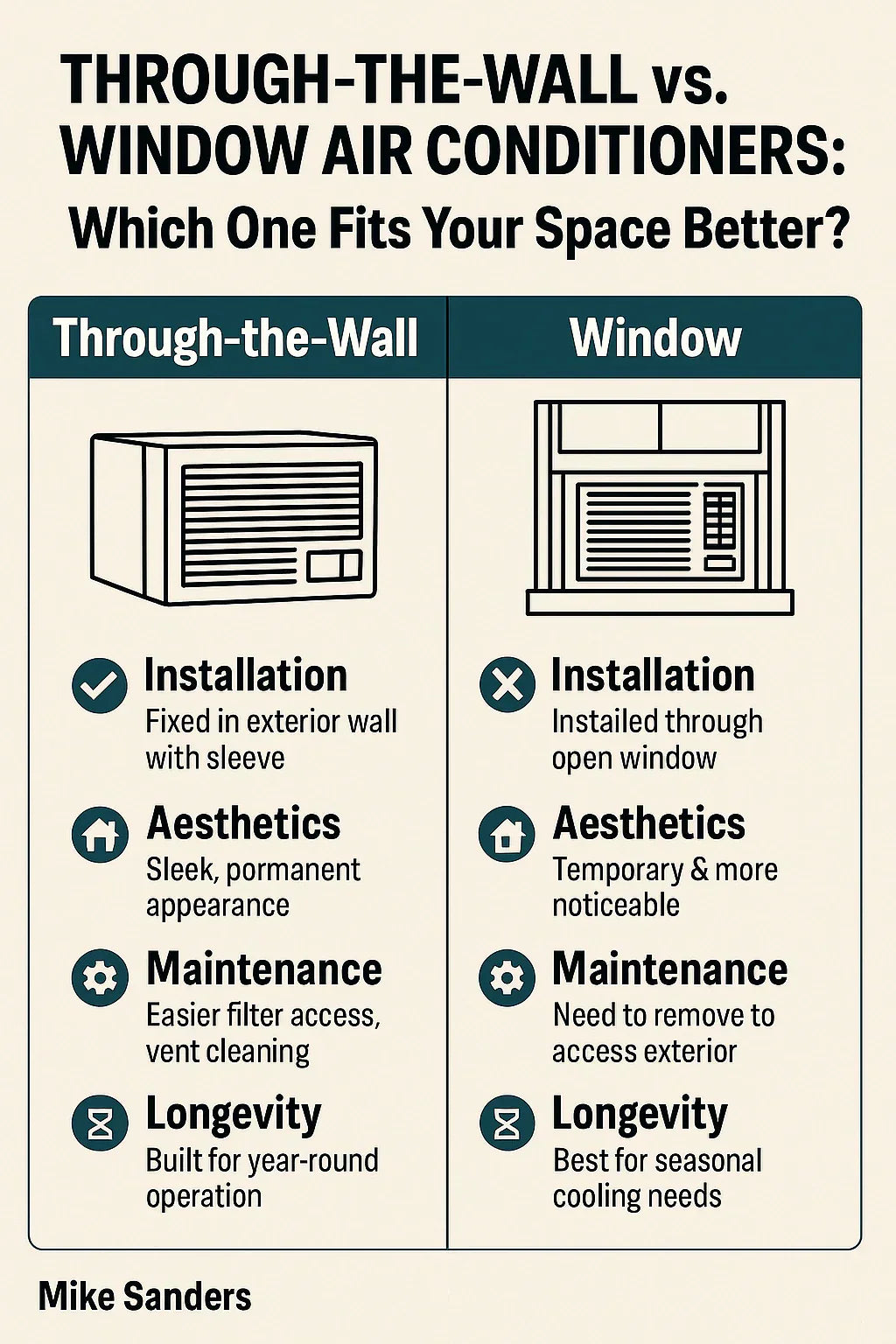🔧 The Two Most Popular Room AC Options
When you're considering an air conditioner for a single room, you typically have two main options: through-the-wall units or window units. While both can deliver effective cooling, they differ significantly in installation, performance, aesthetics, efficiency, and long-term ownership experience.
As your trusted HVAC guide, Mike Sanders is here to break it all down.
🌊 What Is a Through-the-Wall Air Conditioner?
A through-the-wall AC unit, like the Amana PBH092J12AA, is permanently installed by cutting a hole into an exterior wall of your home. It fits inside a specially designed wall sleeve that seals and supports the unit.
Key Features:
-
Permanently mounted
-
Sealed and insulated with sleeve
-
No window space sacrificed
-
Often includes heat pump option for year-round use
Reference: Through-the-Wall Air Conditioner Guide
🔤 What Is a Window Air Conditioner?
A window AC sits inside a standard double-hung window opening. It's designed for quick installation, often requiring minimal tools or permanent changes to the home structure.
Key Features:
-
Fast, DIY-friendly installation
-
Removable/portable
-
Blocks window usage and natural light
-
Less expensive upfront
Reference: Energy Star Room AC Buying Guide
📅 Installation: One-Time vs. Seasonal Setup
| Feature | Through-the-Wall AC | Window AC |
|---|---|---|
| Installation Type | Permanent | Temporary |
| Structural Changes | Wall cutting, sleeve insertion | Minimal (window bracket) |
| Professional Help | Often required | Frequently DIY |
| Removal | Rarely needed | Easy seasonal removal |
Mike's Take:
"Through-the-wall units make sense for long-term use in dedicated spaces. Window units are great if you're a renter or want portable flexibility."
🔋 Energy Efficiency Comparison
Through-the-wall air conditioners typically offer slightly better energy efficiency than window models, especially at higher BTU levels.
-
Better insulation from wall sleeve
-
Fewer air leaks
-
Less outdoor air intrusion
-
Many include heat pump functionality (dual-use year-round)
Window units may have higher leakage rates due to improper sealing around the window frame.
Reference: HVAC.com Energy Efficiency Guide
💡 Cooling Capacity & Sizing
Both types of units come in similar BTU ratings, typically from 5,000 to 14,000 BTUs. The sizing rules are identical based on room square footage.
Example:
-
9,000 BTU = 350-400 sq. ft.
-
12,000 BTU = 450-550 sq. ft.
Through-the-wall units, however, often handle consistent loads better due to more stable installation and slightly better heat exchange.
Reference: Department of Energy Room AC Sizing
🛎️ Noise Levels & Comfort
| Noise Factor | Through-the-Wall AC | Window AC |
| Noise Inside | Lower (more insulated) | Louder |
| External Noise Leakage | Minimal | More likely |
| Long-Term Quiet Performance | Excellent | Variable |
Through-the-wall units often outperform window units in noise management because:
-
Sleeves absorb vibration.
-
Tighter fit reduces drafts.
-
Some models feature advanced soundproofing.
Reference: Consumer Reports: Quietest Air Conditioners
🌟 Aesthetics and Permanent Value
Through-the-Wall:
-
Clean exterior profile
-
Leaves windows unobstructed
-
Matches siding or exterior trim with professional installation
-
Adds value in condos, apartments, sunrooms
Window Units:
-
Visibly protrude from windows
-
Block natural light and views
-
May violate HOA or apartment regulations
-
Decrease curb appeal
For long-term homeowners or real estate value, through-the-wall units generally offer superior visual integration.
Reference: Bob Vila: Best AC Unit Types for Your Home
📅 Maintenance Requirements
| Maintenance Task | Through-the-Wall | Window AC |
| Filter Cleaning | Easy access | Easy access |
| Seasonal Removal | Not required | Required if seasonal |
| Weatherproofing | Permanent once installed | Must reseal yearly |
| Long-Term Durability | Excellent | Moderate |
🌬️ Weather and Seasonal Use
Through-the-Wall Units:
-
Sealed sleeve prevents cold drafts in winter.
-
With heat pump models, offer year-round climate control.
Window Units:
-
Can allow drafts during colder months.
-
Often require full removal for winter storage.
If you live in a region with extreme seasonal changes, through-the-wall offers superior year-round convenience.
Reference: Energy.gov Heat Pump Systems
💲 Upfront Cost vs. Lifetime Value
| Cost Factor | Through-the-Wall | Window AC |
| Unit Cost | Higher | Lower |
| Installation | Moderate to high | Low |
| Lifespan | 10-15 years | 5-7 years |
| Operating Cost | Lower (more efficient) | Higher (seasonal loss) |
| Long-Term ROI | Higher | Lower |
Mike's Take:
"If you're staying put for 5+ years, through-the-wall pays off. For short-term rentals or budget installs, window units win."
🔄 When Each Option Makes Sense
Best Situations for Through-the-Wall AC:
-
Homeowners seeking long-term solution
-
Year-round usage with heat pump
-
High-end condos and apartment retrofits
-
Home offices or bonus rooms
-
HOAs prohibiting window units
Best Situations for Window AC:
-
Renters or short-term living situations
-
Seasonal usage only
-
Smaller rooms with easy access windows
-
Budget-focused cooling
📉 The Mike Sanders Verdict
"When you want a long-term, high-efficiency, and quiet solution that adds value to your property — through-the-wall AC wins hands down. You give up portability, but gain stability, better looks, superior insulation, and modern year-round performance, especially with heat pump models like the Amana PBH092J12AA.
But if you're cooling a temporary apartment or just need budget-friendly summer comfort, a window unit remains a solid quick fix."
In the next topic we will know more about: Heat Pump or Straight Cooling? What to Know Before Buying a Through-the-Wall AC







